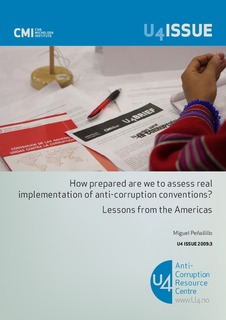How prepared are we to assess real implementation of anti corruption conventions? Lessons from the Americas
Research report
Permanent lenke
http://hdl.handle.net/11250/2474563Utgivelsesdato
2009-03-31Metadata
Vis full innførselSamlinger
- Publications [1488]
Originalversjon
Bergen: Chr. Michelsen Institute (U4 Issue 2009:3) 35 p.Sammendrag
The United Nations Convention against Corruption (UNCAC) is the latest achievement in a series of international anti corruption treaties. All of them share a common challenge – how to meaningfully assess their implementation. In fact, for UNCAC a mechanism to review implementation has yet to be agreed upon. This U4 Issue Paper explores lessons learned from the anti corruption convention that has been in existence longest – the Inter American Convention against Corruption (IACAC) – which gives useful insights into the requirements for an effective review process. In the Americas, as elsewhere, there is often a gap between formal (legal) aspects of reform and the reality of implementation. This paper analyses the IACAC review mechanism and identifies strengths and weaknesses in generating legal and performance related information about the implementation of the convention. Special emphasis is given to the development of an indicator map to assess some key areas of IACAC implementation in Guatemala. The paper argues that strengthening national information systems and information management capacities can generate more objective knowledge about the progress of anti corruption reforms. Performance indicators, in particular, are necessary for meaningful assessments of, and debates about, the status of a convention’s implementation within a particular country. It is the purpose of this Issue Paper to make these lessons learned available to the States Parties to UNCAC in their current discussions on a possible review mechanism for UNCAC. However, this experience can also be useful to the different national actors in each country, as well as to donors in guiding their commitment to provide technical assistance for the implementation and follow up of the UNCAC.
